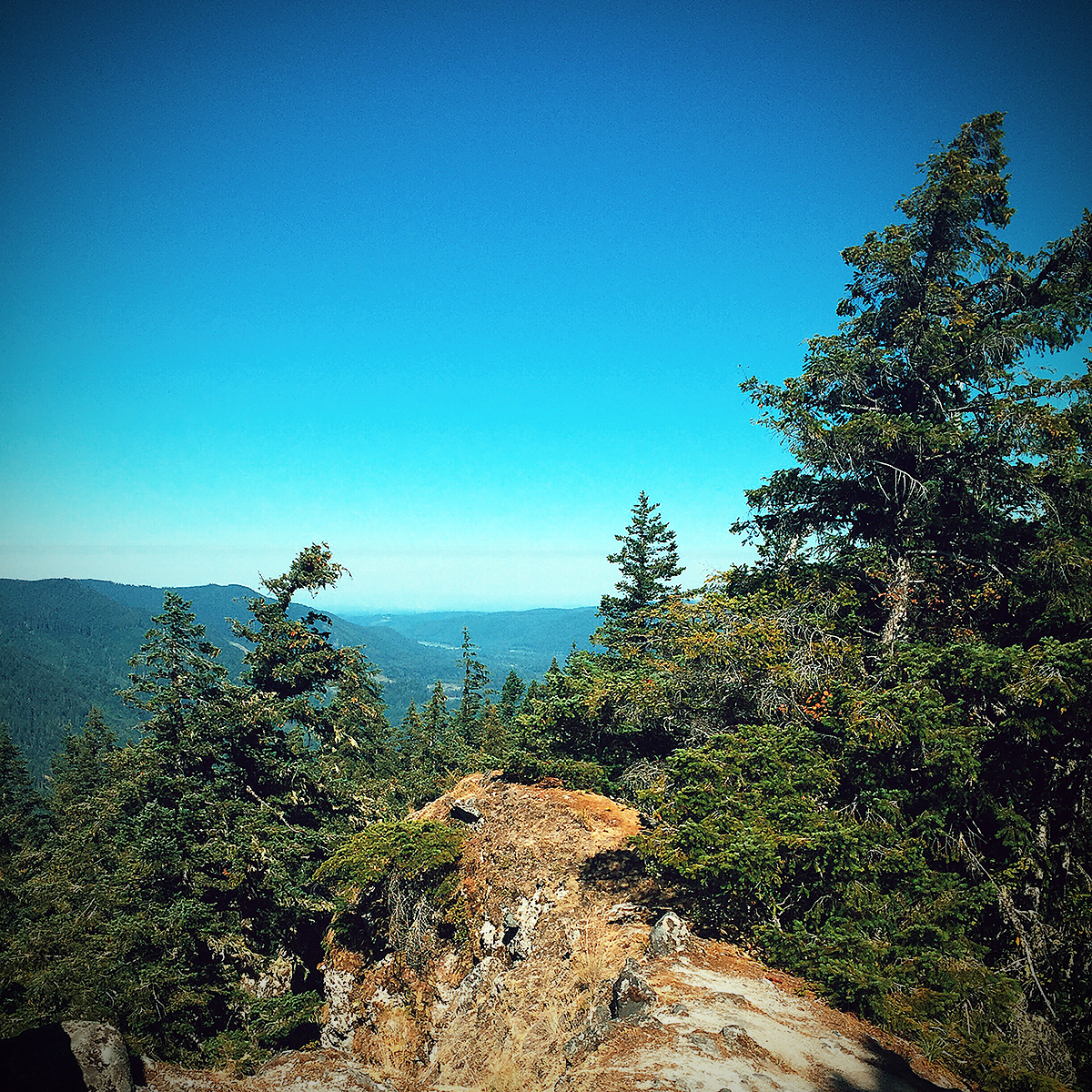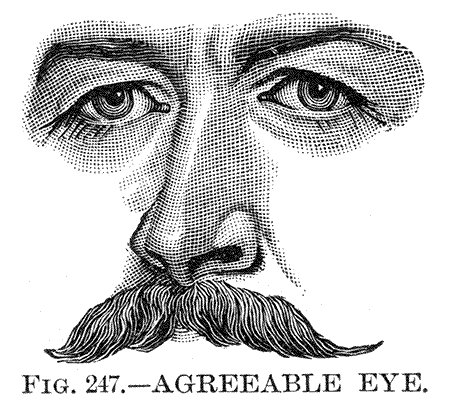a singular philosophy

The view from the ridge,
circa late summer 2017.
The path that I like to walk (and have for some years) is the beginning of a nine-mile trail that goes up to a Forest Service lookout (which I have not yet reached, and probably never will, by that route). The trail climbs a series of rapid switchbacks before descending briefly through a slight depression and rising again in more languorous, arduous switchbacks to an initial eminence where one feels on more equal footing with the trees and the ground is covered with dark glossy leaves, perhaps ivy, but more likely Oregon grape or salal. The trail continues along the ridge to a viewpoint where one can at last see clear through across the valleys to the next line of foothills.
The first time I reached this viewpoint, which one approaches by a short blind scramble, I thought someone had left a large glossy black trash bag on the trail, rustling slightly in the wind. As I came closer, though, it resolved itself into a turkey vulture, which peered at me briefly before hopping awkwardly and flying away. It swooped around a few times, then disappeared behind an outcropping. This viewpoint was also, I believe, the spot where a far-ranging mountain lion attacked and killed a holiday weekend hiker, whose backpack was found later that day. The trail was closed for several weeks as search and rescue teams scoured the slopes, and when it reopened it was marked by the hoofprints of mules, which are the only convenient way to move anything heavy along the trail.
Everything, in this world of work, leisure, activity, reproduction and consumption of things, everything has its function, its place, its utility, and a specific word that corresponds to it. Likewise our grammar reproduces our sequencings of action, our laborious grasp of things, our fuss and bustle. Always doing, producing, forever busying ourselves. Our language is tailored to the conventions of fabricated things, predictable gestures, normalized behaviours, received attitudes. Artifices adapted to one another: language is caught in the everyday construction of the world, participates in it, belongs to the same order of things as pictures and numbers and lists – order, injunction, synthesis, decision, report, code. Language is an instruction slip, a price list.
There are several problems with A Philosophy of Walking. It was intended for a popular audience, and one is tempted to agree with the somewhat derisive observation of Gros’s (unspecified) colleagues who ‘would [not] consider this a serious academic book’ – but not, as Gros imagines them saying, because it is ‘too transparent’ (if by transparent one means clear, coherent, comprehensible), but because it is insufficiently so. A Philosophy of Walking is broken up into short chapters that fall into three types: personal ruminations on walking as practice, light marketing copy for key types of walking (i.e., backpacking, pilgrimage), and précis of literary or philosophical figures who either wrote something about walking or for whom walking formed a significant biographical element (e.g., Kant, Nérval, Nietzsche, Rimbaud, Rousseau). 1
This structure allows latitude for a wide-ranging ramble, but sadly falls into the narrow but already populous meridian of Thoreauvian solipsism that assumes clean laundry but no laundresses (or laundromats). It is a book – despite its topic – that remains saturated with the aroma of libraries and notecards, and it does not sufficiently distinguish between the act of walking and the process of moving from point A to point B. These are two of the broader problems of the book, but there are more specific problems that intrude upon one’s enjoyment: the lack of danger, 2 the lack of women, 3 and the dismissal of urban walking, 4 which ultimately may all be connected to the erasure (or perhaps rather an elision) of time and (more importantly) change. In Gros’s philosophy, every solitary walker ought to aspire to the focus of the long-gom-pa and step apart from time. 5 If nature is encountered, it is wholly external, separate – a view, a difficulty overcome, an accessory to the greater fact of walking.
I would perhaps not have noticed this if the chapter on slowness had not reminded me so powerfully of Nan Shepherd’s The Living Mountain, which Gros does not mention or appear to know. 6 Shepherd’s book is a memoir of her many years walking the Cairngorms in all weathers and moods; this is a feeble description, but what Shepherd captures so magnificently is the way that, even following the same paths, one is always going somewhere new. There is always a sense that the human body is part of nature, is subject to nature, despite crofts and huts erected against the elements. Although scorning the man-made environment, Gros remains tethered to the CV, to the appointment book, to Thoreau’s shack, to Heidegger’s Hütte, to the grocery-store mentality that ripens wild strawberries and bilberries at the same time (191) – and there is a lingering sense that a walk could only be valued by the pilgrim’s badge it yields, even if that badge is the mere fact of walking. 7 I am not being wholly fair, but these are the things that my memory was willing to unearth; these are the things I carry with me on my own walks.
On the path to a road lined with vacation cabins only occupied on weekends by folks driving cars with out-of-state plates, there is an uncanny assemblage of twigs and moss that looks like an old fellow sat on a porch, raising a glass to toast a new arrival. It very much appears to be a made object, twigs and bearding moss arranged to form the appearance of flesh set back on a rough chair of branches and vines. This effect is enhanced by a desire path running at its feet and a bright orange ladder tilted some ten or fifteen yards behind it. A closer inspection reveals, however, that it is fundamentally a natural artifact, an unfortunate stunted conifer sapling that did not survive some previous winter and has gathered moss on its westward branches, while the eastward branches were discouraged by wind or broken off at some earlier date. From the corner of the eye, though, it still appears to be a forked creature raising an arm in camaraderie, ready to tell a tale to unwary passers-by.
- One can set aside, for the moment, the arrogance of summarizing Nietzsche or Rousseau on walking, as both writers have more charm and/or character than most.[↩]
- He does not mention, for instance, that it was on one Rousseau’s solitary walks that the philosopher was struck down by a large dog (and narrowly missed by a carriage), hitting his head against the pavement and suffering a concussion and probable neurological damage that may have hastened the stroke which led to his death; see Walk 2 in Reveries of a Solitary Walker for Rousseau’s account of the incident.[↩]
- I was somewhat surprised that the review by Lauren Elkin, author of a book about women and walking, did not mention this omission.[↩]
- The chapters on strolling and the urban flâneur are given with a somewhat jaded sigh as something obligatory rather than interesting.[↩]
- Or clock time; there are several different senses of time considered, but so lightly that their strands remain somewhat tangled and I am in no humor to untease them.[↩]
- The absence of Shepherd where she would have been relevant and added depth drew my attention to other absences in the book – women rare and only as observers of men, no mention of people outside the white Christian fold as individuals (with the exception of Gandhi). Although I had been favorable disposed towards the book to begin with, these omissions chivvied me from the vestibule of admiration into the dim passageway of disapprobation.[↩]
- Bilberries (myrtille, i.e., Vaccinium myrtillus L. or one of its relatives) begin to ripen August–September; strawberries generally begin to ripen April–June, depending on variety – they can of course appear through November, depending on the weather. I am perhaps being overly skeptical (and perhaps thinking of Oregon’s wild strawberries and huckleberries [V. deliciosum, though it seems silly to call a North American plant by a Latin name], which one would have to be fortunate indeed to find in an edible state on the same trip). I suppose if one has left one’s rucksack up a tree out of some peculiar desire to feel free (from what is not quite clear), then even late strawberries would seem sweet.[↩]
